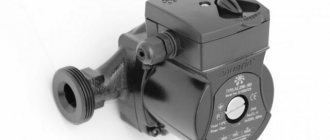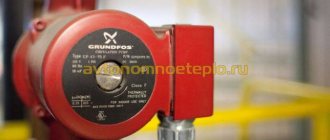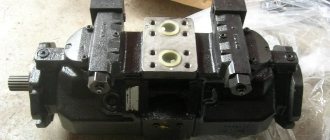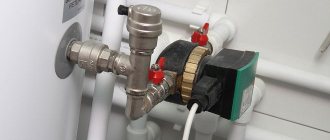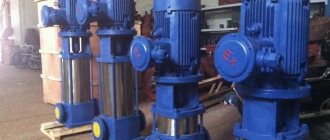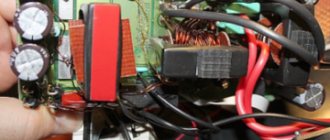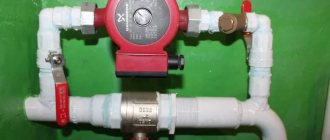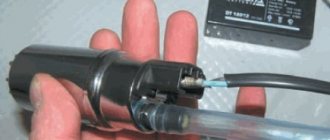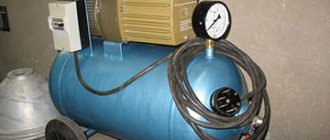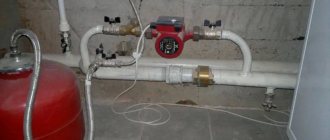Circulation pumps of various types are often used today in country houses and cottages, which makes the operation of autonomous heating systems more efficient and at the same time saves on energy resources. Meanwhile, if such a hydraulic machine fails, the entire heating system stops functioning, which forces its user to choose: use the services of qualified specialists or repair the heating circulation pump with his own hands.
Disassembling the circulation pump
The reasons for the breakdown of circulation pumps, the types of which differ from each other in certain design features, are associated both with non-compliance with the operating rules of such equipment, and with the quality of the coolant, fluctuations in the power supply network, as well as with a number of other factors. Before deciding to repair the circulation pump yourself, you should have a good understanding of the design and operating principle of such a device, which will allow you to determine the exact cause of its failure and eliminate it.
Heating pump repair: breakdowns and solutions
In autonomous heating systems of low-rise buildings and small industrial buildings, household circulation pumps from various manufacturers are used.
The devices differ in power, functionality and reliability.
However, no matter how durable the equipment is, it may happen that you need to repair the heating circulation pump.
As a rule, repair of a heating pump is necessary after 3-6 years of intensive use of the product.
The content of the article
This article will describe the main faults, such as why your heating pump hums, makes noise or crackles, why it gets very hot during operation and many others, as well as troubleshooting methods.
But first, let’s look at the basic design and operating principle of this type of equipment.
Replacing the repair kit
Replacing the circulation apparatus repair kit includes:
- disassembling the pump part of the device;
- replacement of components;
- checking engine operation;
- device assembly;
- diagnostics of equipment operation.
Some manufacturers offer ready-made repair kits for pumping equipment. For example, a repair kit for a circulation pump u4814 with a capacity of 5200 l/h, voltage 12/24 V and a pipe diameter of 38 mm. Purchasing such a kit will reduce the waste of time and money.
Air removal scheme
You should repair the circulation device yourself only after the warranty period has expired or if it is impossible to call a repair specialist. Some pump components are difficult to find on the open market, which is explained by the trade policies of the manufacturing companies.
Design and operating principle
To repair a heating circulation pump with your own hands, you need to know its structure and operating principle. The design of modern devices has changed little since the invention of the first pump.
The most important components are:
metal (or partially metal) body; impeller made of composite material; rotor with rotating shaft; stator and electric motor.
The equipment also includes seals, gaskets, plug bearings, liners, etc. Modern expensive pumps are equipped with an electronic control system that allows you to set and control operating parameters.
All circulation pumps operate on the following principle: under the influence of electric current, the shaft rotates and water is sucked into the housing, where, under the influence of centrifugal forces, it is pushed towards the walls and pushed out under pressure through the outlet pipe.
With proper installation and operation, the device can operate uninterruptedly for decades, and if a malfunction occurs, you can try to repair the heating pump yourself, using a simple set of tools.
Before we begin to consider the features of repairing this type of pump, we recommend reading a review article about heating pumps.
Mechanical problems
There are many reasons why a circulation pump may require repair. The most typical are:
The heating pump hums and does not pump water
Cause: Oxidation and jamming of the rotating shaft.
Remedy: Repair of water pumps in this case involves forcibly turning the shaft and rotor. To do this, you must first turn off the power supply, drain the water and disassemble the device body.
Tip: It can be difficult to turn the shaft by hand. It is better to use a screwdriver with a blunt end for this.
The heating pump crackles, vibrates strongly, and a characteristic howl and hum is heard
Elimination: Repair work is carried out with the unit turned off and consists of disassembling and replacing the bearing. As a rule, the drive shaft bearing is subject to wear, so, first of all, you should pay attention to it.
Tip: When replacing bearings, use ready-made repair kits recommended by the pumping equipment manufacturer.
The heating pump is noisy, the shaft does not rotate
Cause: A foreign object has entered the housing.
Remedy: If the heating circulation pump is noisy, then it is necessary to disassemble it and inspect all parts. If a foreign object is detected, it is carefully removed, and the pump is assembled in the reverse order.
Tip: To prevent debris from getting inside again, it is recommended to install a fine mesh filter on the suction pipe.
Loud noise during operation, but the unit operates normally
Cause: Air in the pipeline or equipment housing.
Remedy: Repair of the heating circulation pump is not required in this case. It is enough to eliminate airiness (bleed air) from the heating system.
The pressure is unstable and constantly changes or decreases gradually.
Cause: The filter on the suction pipe is clogged.
Remedy: Repair of centrifugal pumps involves replacing/cleaning the filter. The filter is removed and cleaned. If there is damage, the filter mesh must be replaced with a new one.
Electrical faults
Why does the heating pump not start or is unstable?
Cause: Broken power cable.
Remedy: It is necessary to carefully inspect the power supply system. The power cord may be broken or the outlet may be faulty. If the power supply is working properly, it is worth inspecting the fuses of the equipment and replacing the blown ones. Often the cause of unstable operation is voltage fluctuations. In this case, it is advisable to use a control relay (for a 220 V network) or a stabilizer (for 380 V).
The heating pump gets hot and does not pump water well into the system
Reason: Working with increased load.
Remedy: If the circulation pump is hot, then this is evidence that it cannot cope with the load. Perhaps the pump was initially selected incorrectly or its power has decreased over time. To solve the problem, a major overhaul of the heating system pump or the purchase of more powerful equipment is often necessary.
Why does the heating pump start but turn off after a few minutes?
Cause: Lime deposits on the stator and/or shaft.
The pump works but vibrates a lot
There are only 2 reasons for this:
- The rotor has somehow shifted from its normal axis of rotation;
- The working shaft bearing is worn out.
The problem is solved by replacing the bearing (if possible) or replacing the pump.
Do-it-yourself heating circulation pump repair: main faults and their elimination
Circulation pumps of various types are often used today in country houses and cottages, which makes the operation of autonomous heating systems more efficient and at the same time saves on energy resources. Meanwhile, if such a hydraulic machine fails, the entire heating system stops functioning, which forces its user to choose: use the services of qualified specialists or repair the heating circulation pump with his own hands.
Disassembling the circulation pump
The reasons for the breakdown of circulation pumps, the types of which differ from each other in certain design features, are associated both with non-compliance with the operating rules of such equipment, and with the quality of the coolant, fluctuations in the power supply network, as well as with a number of other factors. Before deciding to repair the circulation pump yourself, you should have a good understanding of the design and operating principle of such a device, which will allow you to determine the exact cause of its failure and eliminate it.
The pump gets very hot even when the boiler is cold
Excessive heating of the pump using cold coolant indicates that it is operating at increased load. Therefore, you should disassemble it yourself and check everything or send it to a diagnostic center, where this work will be performed by qualified craftsmen.
Design, types and principle of operation of circulation pumps
Without knowing the structure of the circulation pump, you will not only be able to repair such a hydraulic machine if the need arises, but also carry out its regular maintenance. The design of circulation pumps consists of:
- body made of stainless steel or non-ferrous alloys;
- an electric motor whose shaft is connected to the rotor;
- The rotor itself, on which the wheel with blades is installed, is the impeller (its blades, which are in constant contact with the pumped medium, can be made of metal or polymer materials).
Circulation pump design
The circulation pump operates, regardless of its design, according to the following principle.
- After applying electric current, the drive motor shaft begins to rotate the rotor on which the impeller is mounted.
- The coolant liquid entering the internal part of the pump through the suction pipe is thrown away by the impeller and centrifugal force to the walls of the working chamber.
- The liquid, which is affected by centrifugal force, is pushed into the discharge pipe.
As mentioned above, depending on the design features, the heating circulation pump can be of different types. Thus, devices with a rotor are distinguished:
In private homes, “wet” type circulation pumps are most often used.
For circulation pumps of the first type, which are used primarily to equip household heating systems, the rotor is constantly in a liquid medium. This contributes not only to the lubrication of moving elements, but also to their effective cooling. The main advantages of this type of equipment include:
- low noise level during operation, since the water in which all the moving elements of such a device are located perfectly absorbs vibrations;
- ease of installation (such pumps simply cut into the pipeline), maintenance and repair.
Meanwhile, pumps with a “wet” rotor, if we talk about their disadvantages, are characterized by not very high efficiency, can only be installed in a horizontal position and are very critical of the lack of liquid in the heating system.
Pumps with a dry rotor are installed in separate boiler rooms and are used in systems that heat large areas
Inspection of the pump mechanism
In addition to contamination, the main cause of breakdown of the pumping mechanism is long-term dry operation. Due to the lack of liquid, the centrifugal impeller blocks get very hot and sinter, so the only repair option is to replace them. The situation is similar with the auger and landing bushings. Also, with jammed impellers, the shaft can rotate in the mounting holes, and in powerful pumps, it can become deformed and even destroyed.
In screw pumps, screws and landing bushings are consumables; they are replaced every 3–5 years, depending on the intensity of use. The main reasons are the natural aging of elements and exposure to small abrasive particles.
Screw and bushing for auger pump
Let us draw your attention to the fact that the parts of borehole pumps have a high precision of fit, thanks to which the cleaned mechanism is easily assembled and disassembled. If during assembly the parts do not fit into place freely, then the order of installation of the elements is incorrect. Different pump models have specific design differences, but basic recommendations for self-repair and disassembly for inspection purposes are always described in the user manual, which often includes an assembly diagram.
Rules of operation and maintenance
In order not to encounter situations in which the circulation pump installed in the heating system will require repair, it is necessary to strictly follow the operating rules for such equipment, which are as follows.
- If there is no water in the pipeline, the circulation pump cannot be started.
- The amount of water pressure generated must be within the characteristics specified in the technical data sheet of the circulation pump. If the device produces a reduced or, conversely, increased water pressure, this can lead to its rapid wear and, accordingly, failure.
- During the period when the heating system is not in use, the pump must be turned on for circulation at least once a month for a quarter of an hour, which will prevent oxidation and blocking of its moving parts.
- It is very important to ensure that the water temperature in the heating system does not exceed 65°. In water heated to a higher temperature, sediment begins to actively fall out, which, interacting with the moving parts of the hydraulic machine, contributes to their active wear and, accordingly, failure of the entire device.
The circulation pump should be inspected and checked for correct operation monthly. Such measures make it possible to identify malfunctions in the operation of equipment at an early stage and promptly take appropriate measures.
Periodic checking of the circulation pump will significantly reduce the likelihood of its failure during the heating season
Checking the circulation pump for correct operation includes actions such as:
- turning on the hydraulic machine to operating mode and checking the level of noise and vibration it creates;
- checking the pressure (pressure level) of the coolant created in the discharge pipe (as mentioned above, the liquid pressure must be within the values given in the technical data sheet);
- control of the degree of engine heating, which should not be too high;
- checking the presence of lubricant on the threaded connecting elements of the pump and applying it if it is missing;
- checking the presence and correct grounding of the hydraulic machine body;
- checking for leaks both on the pump body and in the places where it is connected to the pipeline (if there are leaks in such places, it is necessary to tighten the threaded connections and check the integrity of the installed gaskets);
- inspecting the terminal box and checking that the wire is fixed in it (in addition, it is necessary to check whether moisture is getting into the terminal box, which is unacceptable).
The main reason for the rapid wear of friction bearings in pumps is considered to be increased contamination of the coolant.
Basic safety rules
Although the design of the circulation pump is quite simple, it will require certain qualifications to eliminate any breakdowns that occur. Therefore, it is easier to prevent a problem than to heroically eliminate it later. One sign that something is wrong with your equipment is if it becomes excessively hot during operation.
Compliance with the simplest operating rules will help prevent this:
- Under no circumstances should the wiring come into contact with moisture.
- Particular care should be taken to check the tightness of the connection between the pumping equipment and the pipeline. If there are leaks, the gaskets should be replaced.
- It is forbidden to turn on the device without first grounding it. The heating pump device includes special terminals.
- The internal pressure force should not exceed operating standards.
To figure out why the heating pump is not working, it is recommended to seek help from a professional technician. You can try to fix simple problems yourself.
The most common faults and their elimination
There are several malfunctions that are most typical for circulation pumps, which are quite possible to fix with your own hands. Such malfunctions can be identified by their characteristic symptoms, without even disassembling the pump or using complex diagnostic equipment.
The pump hums when turned on, but the impeller does not rotate
The reason for the situation when the pump is noisy, but the impeller is motionless, is often due to oxidation of the drive motor shaft. This may occur due to the fact that the hydraulic machine has not been used for a long time. To repair a heating pump with your own hands in case of such a malfunction, you must perform the following steps:
- turn off the electrical power;
- drain all water from the pump and the adjacent pipeline;
- Having unscrewed the corresponding screws, remove the drive motor along with the rotor;
- resting on the working notch of the rotor with your hand or a screwdriver, forcefully turn it, moving it from its dead point.
Disassembled circulation pump
The pump will make noise, but will not work even if a foreign object has entered its interior and blocks the rotation of the impeller. To repair the circulation pump in such a situation, perform the following steps:
- turn off the power supply;
- drain water from the pump and adjacent pipeline;
- disassemble the pump according to the above scheme;
- remove a foreign object;
- install a mesh filter on the inlet pipe.
This is what the circulation pump housing looks like from the inside
The pump is turned on and does not hum or work.
If the turned on circulation pump does not make noise, but does not work, there may be problems with the power supply. To identify the cause and eliminate such a malfunction, disassembling the circulation pump may not be necessary: using a tester, check the level and presence of voltage at the terminals of the device. In many cases, to eliminate such a malfunction, it is enough to correctly connect the pump to the power supply.
Revision of the motor part
Deep well pumps are equipped with a single-phase, mostly brushless induction motor. The connection diagram contains a starting capacitor. The stator of the electric motor has a monolithic attachment to the housing; it is often filled with epoxy compound.
In pumps of a monolithic design, the motor must be squeezed out of the glass by pressing on the connection outlet of the outgoing pipeline with the impellers removed. In rod pumps, the motor part is disconnected when the two halves are separated, in screw pumps - after removing the working screw. In all cases, the insides of the engine (capacitor, connecting terminals) can only be accessed after removing the sealed plug. It is fixed with 2-3 screws on the side surface of the sleeve and a powerful locking ring. In some types of pump, the plug may require the use of a special puller.
Well pump motor stator
All well pump motors are filled with oil, which performs lubricating, cooling and dielectric functions. The oil used is special food grade, but it is commercially available. Signs of low quality may be a cloudy color of the oil when mixed with water, darkening or the presence of mechanical impurities, as well as insufficient levels. If the oil is normal, it should be drained into a clean, dry container, leaving the motor housing for 15–20 minutes until the residue completely drains from the walls. Insufficient oil filling of the engine indicates wear of the oil seals.
In addition to spoiled oil, engine malfunctions can be caused by worn bearings, which can be determined by play and free-wheeling noise. If the pump has been operated for a long time under extreme conditions, the shaft may be bent (twisted) and the winding insulation may overheat. Burnt stators are practically beyond repair, but they are quite easy to replace.
Burning of the stator winding due to water entering the motor
How to prepare a circulation pump for the heating season
Before the start of the heating season, in order not to subsequently encounter failure of the circulation pump and its repair, it is necessary to properly prepare the device for a long period of intensive operation.
- You should check that the pump is inserted correctly into the pipeline, focusing on the arrow on the body and the impeller rotation indicator. When installing a new pipeline for installing a circulating hydraulic machine, it is better to choose an area immediately in front of the boiler, where the risk of air pockets is minimized.
- The gaskets and pipes of the pump must be lubricated to prevent them from drying out.
- It is necessary to check the condition of the strainer on the suction pipe and, if it is clogged, clean it thoroughly.
- It is also necessary to evaluate the correct connection of the pump to the power supply network, for which a tester is used.
- You should check the tightness and reliability of the hydraulic machine connecting units.
- You need to perform a test run, the results of which will show whether your equipment is ready for the heating season.
Possible causes of problems
- no rotor rotation when the pump is connected to the network. As a rule, this indicates some kind of failure in the delivery of power to the equipment. First of all, you need to inspect all the elements directly responsible for this function: electrical wire, device switch, etc. If you find any defect - for example, even the slightest insulation violation - you must immediately replace the damaged part with a new one. Until the defect is eliminated, the device cannot be used, as this is fraught with short circuits and other troubles. After checking the external elements, inspect the plastic fuse. With frequent voltage drops in the electrical network, it begins to melt and constantly opens the circuit. If you see that it is already openly deformed, it needs to be replaced. The next element that needs to be checked is the winding of the electric motor. To do this, you will need a multimeter, which can be used to measure the resistance level. In normal winding conditions, the indicator can vary from 10 to 15 Ohms or from 35 to 40 Ohms, depending on the specific rotor model. If the multimeter produces infinity or a value close to zero, then this indicates the need to replace the winding;
- pump overheating. This usually happens in cases where the circulation equipment for some reason is forced to work under increased load. Detecting overheating is quite simple - if the pump is hotter than the pipe, then this clearly indicates a problem. In the case when this happens with newly installed new equipment, it makes sense to check the correctness of the installation. Incorrect placement of the device may cause it to malfunction. If you find any shortcomings, you need to re-perform the installation procedures, making the appropriate adjustments. Another common cause of overheating is clogging of structural elements with dirt. Rust and scale play a big role in this. They form in some parts of the pipeline, and then fall off piece by piece and go along with the coolant, clogging all the equipment where they fall. This happens with the circulation pump. The presence of foreign particles inside the structure narrows the path along which the coolant flows. Thus, the pump has to apply more force to move the liquid. That's why overheating occurs. The solution to the problem in this case is to clean the clogged elements. The third reason for overheating has already been mentioned above - it may be an insufficient amount of lubricant on the bearings located inside the pump. The fourth reason may be too low - below 220 V - the voltage in the network. You need to check this indicator with a voltmeter and, if problems are found, correct them;
- poor coolant current. This refers to situations where the fluid circulates at insufficient speed. The reason for this may be an incorrect connection if your home uses a 380 V network. Check that the electrical wire is connected to the phase correctly - it is quite possible that it needs to be connected to another. The second reason for poor current may be the same clogging of internal structural elements mentioned above. This can be solved by cleaning the elements.
Modern boiler room
| Name and technical characteristics | Qty | Unit. | Materials and equipment | Installation work | Total materials | Total work | total cost |
| Hydraulic leveler | 1,00 | PC. | 8 500 ₽ | 2 500 ₽ | 8 500 ₽ | 2 500 ₽ | 11 000 ₽ |
| Distribution manifold number of consumer circuits 2 | 1,00 | PC. | 9 500 ₽ | 2 500 ₽ | 9 500 ₽ | 2 500 ₽ | 12 000 ₽ |
| Distribution manifold number of consumer circuits 3 | 1,00 | PC. | 10 500 ₽ | 2 500 ₽ | 10 500 ₽ | 2 500 ₽ | 13 000 ₽ |
| Distribution manifold number of consumer circuits 4 | 1,00 | PC. | 11 500 ₽ | 2 500 ₽ | 11 500 ₽ | 2 500 ₽ | 14 000 ₽ |
| Distribution manifold number of consumer circuits 5 | 1,00 | PC. | 12 500 ₽ | 2 500 ₽ | 12 500 ₽ | 2 500 ₽ | 15 000 ₽ |
| Distribution manifold fasteners | 2,00 | PC. | 1 200 ₽ | 350 ₽ | 2 400 ₽ | 700 ₽ | 3 100 ₽ |
| Pump module without mixing valve and pump | 1,00 | PC. | 6 500 ₽ | 2 500 ₽ | 6 500 ₽ | 2 500 ₽ | 9 000 ₽ |
| Pump module with mixing valve without pump | 1,00 | PC. | 8 500 ₽ | 2 500 ₽ | 8 500 ₽ | 2 500 ₽ | 11 000 ₽ |
| Pump module with mixing valve and servomotor without pump | 1,00 | PC. | 12 500 ₽ | 2 500 ₽ | 12 500 ₽ | 2 500 ₽ | 15 000 ₽ |
| Connection of the pump module to the consumer circuit | 1,00 | PC. | — | 3 500 ₽ | — | 3 500 ₽ | 3 500 ₽ |
| Pressure testing of a modular boiler room | 1,00 | PC. | — | 3 000 ₽ | — | 3 000 ₽ | 3 000 ₽ |
| Connection of a modular boiler room with a heating boiler | 1,00 | PC. | — | 3 500 ₽ | — | 3 500 ₽ | 3 500 ₽ |
| Fittings and adapters for boiler room assembly. Copper pipes ⌀22-28, footage no more than 25 m/linear. | 1,00 | computer | 14 000 ₽ | — | 14 000 ₽ | — | 14 000 ₽ |
| Heating system circulation pump 25*40 | 1,00 | PC. | 4 312 ₽ | 720 ₽ | 4 312 ₽ | 720 ₽ | 5 032 ₽ |
| Heating system circulation pump 25*60 | 1,00 | PC. | 4 560 ₽ | 720 ₽ | 4 560 ₽ | 720 ₽ | 5 280 ₽ |
| Heating system circulation pump 25*80 | 1,00 | PC. | 8 670 ₽ | 720 ₽ | 8 670 ₽ | 720 ₽ | 9 390 ₽ |
Modern boiler room
| Total cost of work | RUB 32,860 |
| Total cost of equipment | RUB 113,942 |
| Total total cost | RUB 146,802 |
Modern boiler room
